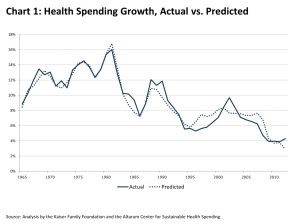 Why has health cost growth in the U.S. slowed in the past few years? It’s mostly due to the economy, argues the Kaiser Family Foundation in Assessing the Effects of the Economy on the Recent Slowdown of Health Spending.
Why has health cost growth in the U.S. slowed in the past few years? It’s mostly due to the economy, argues the Kaiser Family Foundation in Assessing the Effects of the Economy on the Recent Slowdown of Health Spending.
The answer to this question is important because, as the American economy recovers, it begs the next question: will costs increase faster once again as they did in previous go-go U.S. economies, further exacerbating the budget deficit problems in the long-term?
KFF worked with Altarum to develop an economic model to answer these questions.
The chart illustrates the predicted vs. actual health spending growth numbers based on the modeling. It shows that health spending increases have been slowing in the past several years, down from the double-digit spikes of the 1970s, early 1980s and early 1990s. Then Clinton health reform threatened the industry and cost growth slowed in the latter 1990s.
KFF/Altarum consider many reasons for the recent cost-growth slowdown. Utilization management, more defined contribution and consumer-directed health care with higher consumer cost-sharing have rationalized consumer demand for health care. The analysis also notes that some the growth of health IT and ability to track and manage health service use in real-time might slow unnecessary utilization and, thus, spending.
The economic impacts are direct and indirect:
- Direct, as consumers use fewer health care services as incomes lag and, as a result, people cut back on personal spending; and
- Indirect, as employers reduce health benefits and more people are uninsured.
While the economy is the major factor in the health cost slowdown, based on the model, the team also points to structural changes in health care delivery that may be kicking in to slow the cost spiral — in particular, patient cost-sharing that “discourages use of services.” The report stops short in pinning down these impacts, but does argue that as the economy improves, health spending will probably also increase — although not to a 1970s deja vu double-digit growth level.
Health Populi’s Hot Points: There’s another reason health costs will increase in the period 2014-2016: as millions of people in the U.S. begin to access health insurance anew, they will be eventually using health services they haven’t accessed for some time. KFF expects this period to also be one of economic growth, so that it may be hard to tease out health cost growth due to the economic effect versus the ACA-effect.
At the same time as the ACA is being implemented for Medicare and Medicaid (public sector programs), there are structural changes occurring in the commercial/private market among employers who choose to continue to provide health benefits. These will largely be morphing toward consumer-directed plans with higher deductibles, copayments, and coinsurance amounts, coupled with value-based benefit designs nudging people toward health and wellness programs and engagement.
While the economy has been the major driver in health cost growth, and slowdown, I expect to see these structural factors contribute more toward spending as consumers gain more influence over their own health shopping and spending toward a more consumer-centric health economy.




 Thanks to Feedspot for naming this blog, Health Populi, as a
Thanks to Feedspot for naming this blog, Health Populi, as a